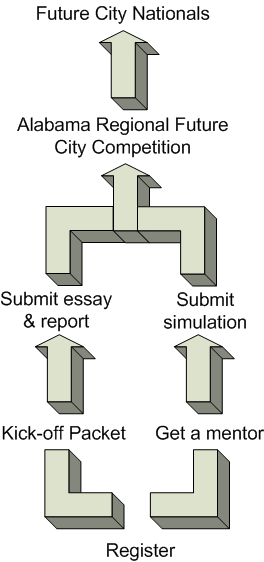|
Phase 1: Design City
The team designs its City of the Future using SimCity 3000 software. The program requires the teams to control development rate using constraints found when building real cities (taxes, traffic congestion, pollution, etc.) using realistic schedules. They develop their city considering a specific engineering problem in the competition.
Phase 2: Build Model
The team builds a 30"x60"x24" high (max.) model of a section of their city to scale. The model must contain at least one moving part, such as a transportation or communications component. If a power source is used, the power must be self-contained.
The team chooses materials to use in model construction, such as Styrofoam, balsa wood, cardboard, clay, or toothpicks. They must manage the total model cost of materials and presentation to no more than $100, using soft drink bottles, empty containers, candy boxes, and a various other materials in the models, recycling as much as possible.
Phase 3: Compose Essays
The students compose two essays, the first a short abstract describing their city and its services, giving the judges a quick overview of the city design.
They also write a longer essay, using detailed research and a bibliography of references. They base the essay on the engineering problem assigned at the start of competition. They must develop an solution to the engineering problem, and then use and describe the design applying that solution to the problem. The teams provide futuristic and visionary designs, but base the solution on realistic engineering design principles.
The students will write this year's Abstract & Essay on the importance of using fuel cells to power cities. They will develop an energy strategy that includes fuel cell systems to power a future city.
Phase 4: Competition Day
The student teams from all schools congregate for an all day judging event. The students deliver a presentation to judges of engineers and planners discussing their city and amenities. This presentation is no more than 7 minutes, strictly timed at both regional and national competitions. The judges also evaluate the students on how well they explain the design and function of their futuristic city. The rules encourage students to use flip chart or poster-sized materials to present their city to judging panels. Once the students complete their presentations, the judges question them for an additional 3-5 minutes to determine depth of knowledge relative to their city and the engineering principles learned.
Competition Awards
1st place - Trophies and $250 (towards the school's computer/science program), and trip to National competion in Washington, D.C.
2nd place - Trophies and $200 (towards the school's computer/science program).
3rd place - Trophies and $150 (towards the school's computer/science program).
Special Awards - Certificates and $125 (towards the school's computer/science program).
All teams will receive Future City Participation Medals.
The first place team represents the region in the National Future City Competition in Washington, D.C. during National Engineers Week, held annually in February. They compete there for one of three national awards as well as a number of national special awards with teams from 37 other regional competitions around the country.
|  |

